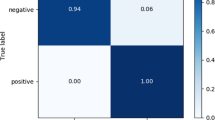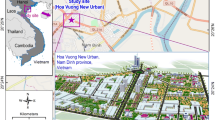Abstract
The magnitude of soil settlement depends on several variables such as the compression index, Cc, and recompression index, Cr, which are determined by a consolidation test. This laboratory test is time consuming and labor intensive, thus efforts to correlate the compressibility indexes and soil index properties have been made. In this study, soil compressibility prediction models are enhanced by the support vector machine (SVM) algorithm, and the performances of those correlations are tested via field verification in terms of settlement calculation. The field verification portion of the study consists of identifying sites with borings, consolidation tests, and measured settlement from overlying load. Soil layers, within the influence zone of settlement, are tested to obtain soil index parameters. Once a complete soil profile has been established, a series of settlement analyses were performed. Settlement predictions were made based on both predicted and measured Cr for each soil layer. An additional settlement prediction was made using a rule of thumb equating Cc to Cr. The predicted settlements were then compared to the measured settlement taken in close proximity. Upon conclusion, using the Cr and Cc correlations provides comparable settlement predictions compared to measured settlement and the predicted Cr (using a correlation from predicted Cc) exhibits the strongest settlement predictions. The predicted settlements are lower than the measured settlements for both site locations. This leads one to believe that the influence zone of settlement may be deeper than originally considered.









Similar content being viewed by others
References
Azzouz AS, Krizek RJ, Corotis RB (1976) Regression analysis of soil compressibility. Soils Found 16(2):19–29
Koppula SD (1981) Statistical estimation of compression index. Geotech Test J 4(2):68
Herrero AM (1983) Universal compression index equation. J Geotech Eng 109(5):755–761
Park HI, Lee SR (2011) Evaluation of the compression index of soils using an artificial neural network. Comput Geotech 38(4):472–481
Miyakawa I (1960) Some aspects of road construction in peaty of marshy areas in Hokkaido. In: Hokkaido Development Bureau. Civil Engineering Research Institute, Sapporo (text in Japanese)
Cook PN (1956) Consolidation characteristics of organic soils. In: Proc., 9th Canadian Soil Mechanics Conf., vol 41, NRC, ACSSM, Technical Memorandum, Ottawa, 82–87
Nishida Y (1956) A brief note on compression index of soils. J Soil Mech Found Div 82(3):1–14
Cozzolino VM (1961) Statistical forecasting of compression index. In: Proc. 5th Int. Conf. on Soil Mechanics and Foundation Engineering, vol 1, Paris, 51–53
Sowers GB (1970) Introductory soil mechanics and foundations, 3rd edn. Macmillan, London
Bowles JE (1989) Physical and geotechnical properties of soils. McGraw-Hill, New York
Ahadiyan J, Ebne JR, Bajestan MS (2008) Determination of soil compression index, Cc, in Ahwaz region. J Faculty Eng 35(3):75–80
Hough BK (1957) Basic soils engineering. Ronald Press, New York
Mayne PW (1980) Cam-clay predictions of undrained strength. J Geotech Eng Div 106(11):1219–1242
Terzaghi K, Peck RB (1967) Soil mechanics in engineering practice, 2nd edn. Wiley, New York
McClelland B (1967) Progress of consolidation in delta front and pro-delta clays on the Mississippi River. Marine geotechnique. University of Illinois Press, Champaign, pp 22–40
Al Khafaji AWN, Andersland OB (1992) Equations for compression index approximation. J Geotech Eng. https://doi.org/10.1061/(ASCE)0733-9410(1992)118:1(148)
Yoon GL, Kim BT (2006) Regression analysis of compression index for Kwangyang Marine Clay. KSCE J Civ Eng 10(6):415–418
Ozer M, Isik NS, Orhan M (2008) Statistical and neural network assessment of the compression index of clay-bearing soils. Bull Eng Geol Environ 67(4):537–545
Elnaggar HA, Krizek RJ (1970) Statistical approximation for consolidation settlement. Highway Res Rec 323(1):87–96
Peck RB, Reed WC (1954) Engineering properties of Chicago subsoils. Engineering Experiment Station, Univ. of Illinois, Urbana
Kirts S, Panagopoulos O, Xanthopoulos P, Nam B (2017) Soil-compressibility prediction models using machine learning. J Comput Civil Eng 32:1
Bishop CM (2006) Pattern recognition and machine learning. Springer, New York
Liu S, Cai G, Puppala AJ, Tu Q (2011) Prediction of embankment settlements over Marine Clay using piezocone penetration tests. Bull Eng Geol Environ 70(3):401–409
Abu-Farsakh M, Yu X (2013) Comparison of predicted embankment settlement from piezocone penetration test with field measurement and laboratory estimated. Geotech. and Geoph. S. Char. 4—Proc. 4th Int. Conf. on Site Characterization, ISC-4, vol 7, pp 349–355
Salem M, El-Sherbiny R (2013) Comparison of measured and calculated consolidation settlements of thick under consolidated clay. Alexandria Eng J 53(1):107–117
Dhowian AW, Erol AO, Sultan S (1987) Settlement predictions in complex Sabkha soil profiles. Bull Int Assoc Eng Geol 36(1):11–21
Leu SS, Chen CN, Chang SL (2001) Data mining for tunnel support stability: neural network approach. Autom Constr 10(4):429–441
Melhem HG, Cheng Y (2003) Prediction of remaining service life of bridge decks using machine learning. J Comput Civ Eng. https://doi.org/10.1061/(ASCE)0887-3801(2003)17:1(1)17(1)
Sou-Sen L, Hsien-Chuang L (2004) Neural-network-based regression model of ground surface settlement induced by deep excavation. Autom Constr 13(3):279–289
Panagopoulos AA, Alam M, Rogers A, Jennings NR (2015) AdaHeat: A general adaptive intelligent agent for domestic heating control. In: Proc. 2015 Int. Conf. on Autonomous Agents and Multiagent Systems. International Foundation for Autonomous Agents and Multiagent Systems, Richland, SC, pp 1295–1303
Panagopoulos AA, Chalkiadakis G, Jennings RN (2015) Towards optimal solar tracking: a dynamic programming approach. In: Proc., 29th AAAI Conf. on Artificial Intelligence (AAAI-2015), AAAI Press, Palo Alto, CA
Sewell JA, Abboud MA (2012) Final plans update geotechnical report for roadways SR 415 widening from the Seminole County line to Reed Ellis Rd. Volusia County, Florida financial project I.D. 407355-3. Professional Services Industries, Inc. Orlando, FL
Das BM (2002) Principles of geotechnical engineering. Thomson Learning, Urbana
Acknowledgements
The authors thank the support from Dr. David Horhota, Mr. Jose Hernando, and the CPT operation crew from Florida Department of Transportation (FDOT) State Materials Office.
Author information
Authors and Affiliations
Corresponding author
Rights and permissions
About this article
Cite this article
Kirts, S., Nam, B.H., Panagopoulos, O.P. et al. Settlement Prediction Using Support Vector Machine (SVM)-Based Compressibility Models: A Case Study. Int J Civ Eng 17, 1547–1557 (2019). https://doi.org/10.1007/s40999-019-00421-6
Received:
Revised:
Accepted:
Published:
Issue Date:
DOI: https://doi.org/10.1007/s40999-019-00421-6




